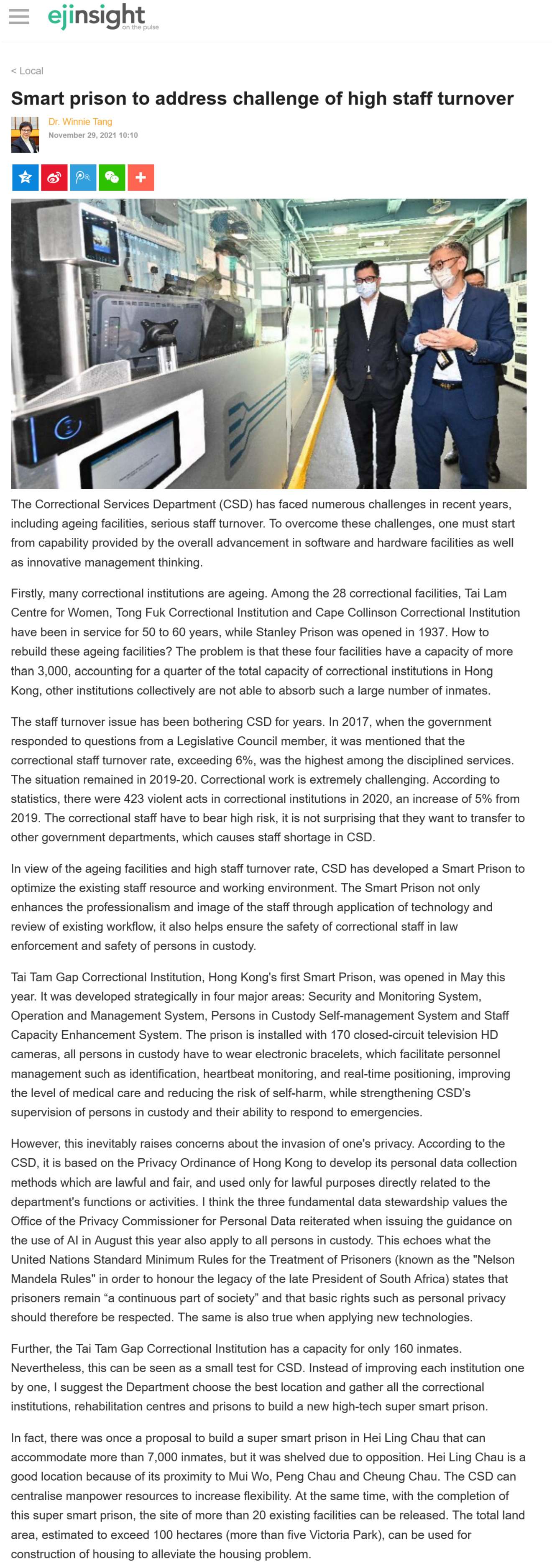網上版請按此

Smart prison to address challenge of high staff turnover
The Correctional Services Department (CSD) has faced numerous challenges in recent years, including ageing facilities, serious staff turnover. To overcome these challenges, one must start from capability provided by the overall advancement in software and hardware facilities as well as innovative management thinking.
Firstly, many correctional institutions are ageing. Among the 28 correctional facilities, Tai Lam Centre for Women, Tong Fuk Correctional Institution and Cape Collinson Correctional Institution have been in service for 50 to 60 years, while Stanley Prison was opened in 1937. How to rebuild these ageing facilities? The problem is that these four facilities have a capacity of more than 3,000, accounting for a quarter of the total capacity of correctional institutions in Hong Kong, other institutions collectively are not able to absorb such a large number of inmates.
The staff turnover issue has been bothering CSD for years. In 2017, when the government responded to questions from a Legislative Council member, it was mentioned that the correctional staff turnover rate, exceeding 6%, was the highest among the disciplined services. The situation remained in 2019-20. Correctional work is extremely challenging. According to statistics, there were 423 violent acts in correctional institutions in 2020, an increase of 5% from 2019. The correctional staff have to bear high risk, it is not surprising that they want to transfer to other government departments, which causes staff shortage in CSD.
In view of the ageing facilities and high staff turnover rate, CSD has developed a Smart Prison to optimize the existing staff resource and working environment. The Smart Prison not only enhances the professionalism and image of the staff through application of technology and review of existing workflow, it also helps ensure the safety of correctional staff in law enforcement and safety of persons in custody.
Tai Tam Gap Correctional Institution, Hong Kong's first Smart Prison, was opened in May this year. It was developed strategically in four major areas: Security and Monitoring System, Operation and Management System, Persons in Custody Self-management System and Staff Capacity Enhancement System. The prison is installed with 170 closed-circuit television HD cameras, all persons in custody have to wear electronic bracelets, which facilitate personnel management such as identification, heartbeat monitoring, and real-time positioning, improving the level of medical care and reducing the risk of self-harm, while strengthening CSD’s supervision of persons in custody and their ability to respond to emergencies.
However, this inevitably raises concerns about the invasion of one's privacy. According to the CSD, it is based on the Privacy Ordinance of Hong Kong to develop its personal data collection methods which are lawful and fair, and used only for lawful purposes directly related to the department's functions or activities. I think the three fundamental data stewardship values the Office of the Privacy Commissioner for Personal Data reiterated when issuing the guidance on the use of AI in August this year also apply to all persons in custody. This echoes what the United Nations Standard Minimum Rules for the Treatment of Prisoners (known as the "Nelson Mandela Rules" in order to honour the legacy of the late President of South Africa) states that prisoners remain "a continuous part of society" and that basic rights such as personal privacy should therefore be respected. The same is also true when applying new technologies.
Further, the Tai Tam Gap Correctional Institution has a capacity for only 160 inmates. Nevertheless, this can be seen as a small test for CSD. Instead of improving each institution one by one, I suggest the Department choose the best location and gather all the correctional institutions, rehabilitation centres and prisons to build a new high-tech super smart prison.
In fact, there was once a proposal to build a super smart prison in Hei Ling Chau that can accommodate more than 7,000 inmates, but it was shelved due to opposition. Hei Ling Chau is a good location because of its proximity to Mui Wo, Peng Chau and Cheung Chau. The CSD can centralise manpower resources to increase flexibility. At the same time, with the completion of this super smart prison, the site of more than 20 existing facilities can be released. The total land area, estimated to exceed 100 hectares (more than five Victoria Park), can be used for construction of housing to alleviate the housing problem.
Dr. Winnie Tang
Adjunct Professor, Department of Computer Science, Faculty of Engineering; Department of Geography, Faculty of Social Sciences; and Faculty of Architecture, The University of Hong Kong